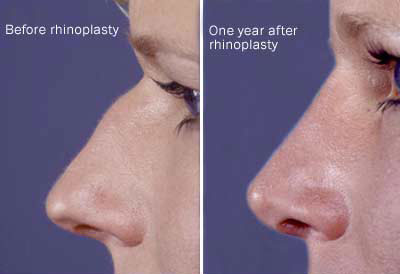Rhinoplasty/Overview
This is surgery, done to shape the nose, as it can make the nose larger or smaller, or change the angle of the nose in relation to the upper lip; and also alter the tip of the nose; or correct bumps; indentations, or other defects in the nose. During this procedure, the surgeon makes incisions to access the bones and cartilage which support the nose,these incisions are usually made inside the nose so that they are invisible after the surgery. It depends on the desired result, as some bone and cartilage may be removed, or the tissue may be added . After that, the surgeon, would rearrange and reshape the bone and the cartilage, the skin and tissue is then re-draped over the structure of the nose. A splint is then placed outside of the nose to support the new shape of the nose as it heals. Nasal packing is used inside the nose to provide additional support
This procedure is done under general anaesthesia, and it usually done as an outpatient procedure , but sometimes requires hospitalisation for a day, after the surgery. Surgeons who perform these kind of cosmetic surgeries, usually have training in either plastic surgery, otolaryngology (ear,nose and throat speciality), or both.

What To Expect After Surgery
The surgical packing inside the nose will be removed within 2 days after the surgery, the splint and the bandage around the nose will be removed about a week. The face will feel puffy and the area around the eyes and nose will be bruised,and swollen for several days. The cold compresses, can help minimise, the swelling and also reduce pain. The doctor may also recommend pain medication. It takes about 10-14 days before most of the swelling and bruising improves. The doctor would advise you to keep your head elevated and still, for a few days, after the surgery, this may be several weeks before you can return to your normal activities.
Why It Is Done
This type of procedure is done to change, the shape, size and angle of the nose and bring it into a better proportion with the rest of the face. This may also correct the structural problems with the nose, which cause chronic congestion and breathing problems.
Risks
There would be temporary swelling, and bruising around the eyes and the nose after rhinoplasty,there are also other problems, which include:
Bleeding.
Injury to the septum( the wall that separates your nostrils)
Problems, associated with the skin, including the breakdown of skin tissue(skin necrosis) and irritation from the tape and bandaging.
Infection.
Antibiotics , which may be given after surgery to reduce the risk of infection
Swelling inside the nose caused by serious nasal blockage
Complications of anaesthesia,and also possible that the cosmetic results of the surgery will not be what you wanted.